Bird R.B., Stewart W.E., Lightfoot E.N. Transport Phenomena
Подождите немного. Документ загружается.


518.2
Diffusion Through a Stagnant Gas Film
547
Substitution of
Eq.
18.2-1 into
Eq.
18.2-3 gives
For an ideal gas mixture the equation of state is
p
=
cRT,
so that at constant temperature
and pressure
c
must be a constant. Furthermore, for gases
aAB
is very nearly indepen-
dent of the composition. Therefore, can be moved to the left of the derivative opera-
tor to get
This is a second-order differential equation for the concentration profile expressed as
mole fraction of
A.
Integration with respect to
z
gives
A
second integration then gives
If we replace
C,
by -In
K,
and
C2
by -In
K,,
Eq. 18.2-7 becomes
The two constants of integration,
K,
and
K,,
may then be determined from the boundary
conditions
B.C.
1:
B.C.
2:
at
z
=
z,,
xA
=
xA,
at
z
=
z2,
x,
=
x~2
When the constants have been obtained,
we
get finally
The profiles for gas
B
are obtained by using
xB
=
1
-
x,. The concentration profiles are
shown in Fig. 18.2-1. It can be seen there that the slope dxA/dz is not constant although
N,
is; this could have been anticipated from
Eq.
18.2-1.
Once the concentration profiles are known, we can get average values and mass
fluxes at surfaces. For example, the average concentration of
B
in the region between
2,
and z, is obtained as follows:
in which
5
=
(z
-
z,)/(z,
-
z,) is a dimensionless length variable. This average may be
rewritten as
That is, the average value of
xB
is the logarithmic mean, (x,),,, of the terminal concen-
trations.
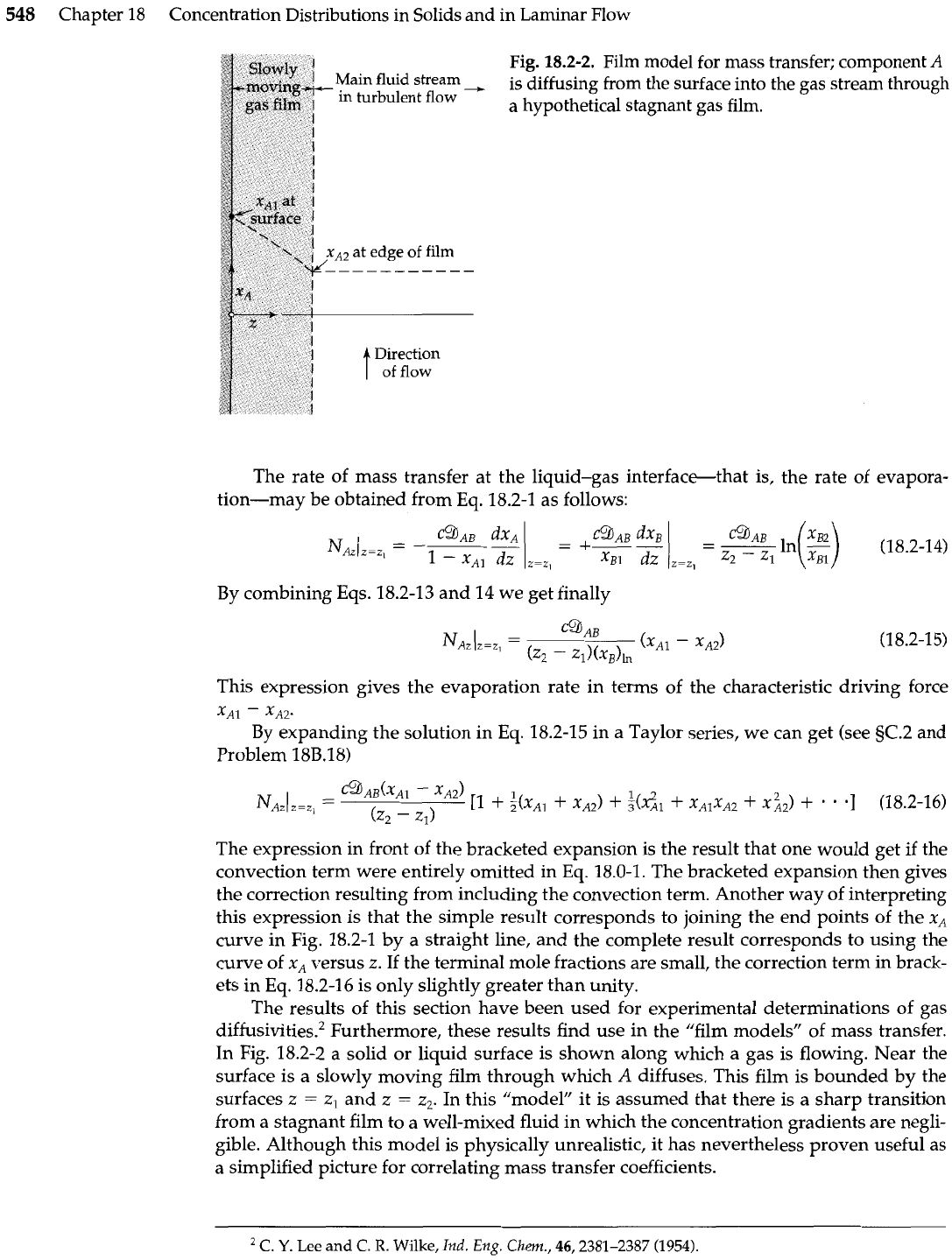
548
Chapter
18
Concentration Distributions in Solids and in Laminar Flow
Main fluid stream
-
in turbulent
flow
Fig.
18.2-2.
Film model for mass transfer; component
A
is diffusing from the surface into the gas stream through
a hypothetical stagnant gas film.
The rate of mass transfer at the liquid-gas interface-that is, the rate of evapora-
tion-may be obtained from Eq. 18.2-1 as follows:
By combining Eqs. 18.2-13 and 14 we get finally
This expression gives the evaporation rate in terms of the characteristic driving force
XAl
-
x~2.
By expanding the solution in
Eq.
18.2-15 in a Taylor series, we can get (see 5C.2 and
Problem 18B.18)
The expression in front of the bracketed expansion is the result that one would get if the
convection term were entirely omitted in Eq. 18.0-1. The bracketed expansion then gives
the correction resulting from including the convection term. Another way of interpreting
this expression is that the simple result corresponds to joining the end points of the
x,
curve in Fig. 18.2-1 by a straight line, and the complete result corresponds to using the
curve of
x,
versus
z.
If the terminal mole fractions are small, the correction term in brack-
ets in Eq. 18.2-16 is only slightly greater than unity.
The results of this section have been used for experimental determinations of gas
diffusivities.' Furthermore, these results find use in the "film models" of mass transfer.
In Fig. 18.2-2 a solid or liquid surface is shown along which a gas is flowing. Near the
surface is a slowly moving film through which
A
diffuses. This film is bounded by the
surfaces
z
=
z,
and
z
=
z2
In this "model" it is assumed that there is a sharp transition
from a stagnant film to a well-mixed fluid in which the concentration gradients are negli-
gible. Although this model is physically unrealistic, it has nevertheless proven useful as
a simplified picture for correlating mass transfer coefficients.
*
C.
Y.
Lee
and
C.
R.
Wilke,
Ind.
Eng.
Chem.,
46,2381-2387
(1954).
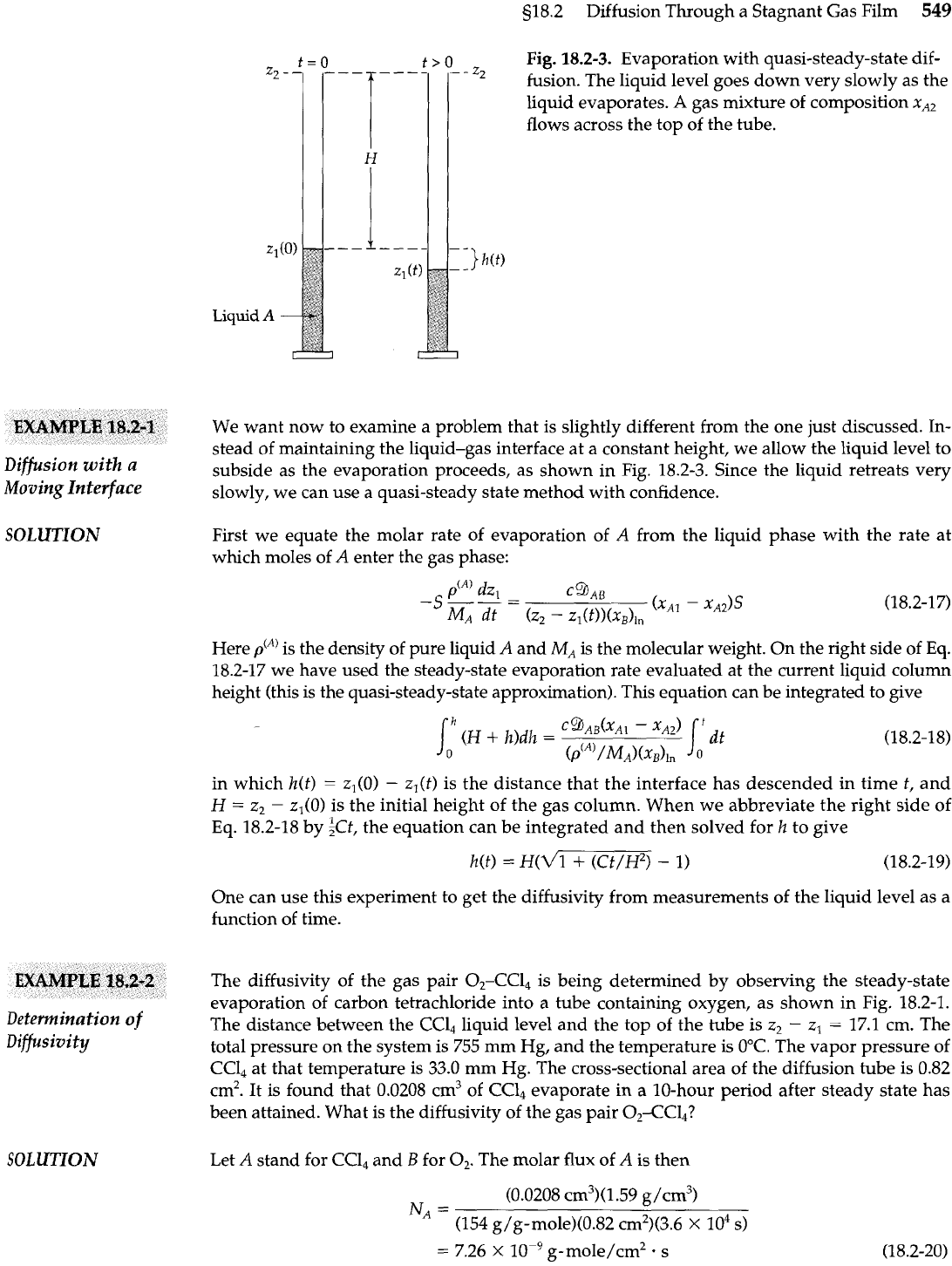
s18.2 Diffusion Through a Stagnant Gas Film
549
Fig.
18.2-3.
Evaporation with quasi-steady-state dif-
fusion. The liquid level goes down very slowly as the
liquid evaporates.
A
gas mixture of composition
xA2
flows across the top of the tube.
Liquid
A
We want now to examine a problem that is slightly different from the one just discussed. In-
stead of maintaining the liquid-gas interface at a constant height, we allow the liquid level to
Diffusion
with
a
subside as the evaporation proceeds, as shown in Fig. 18.2-3. Since the liquid retreats very
Moving Interface
slowly, we can use a quasi-steady state method with confidence.
SOLUTION
First we equate the molar rate of evaporation of
A
from the liquid phase with the rate at
which moles of
A
enter the gas phase:
Here
p(A'
is the density of pure liquid
A
and
MA
is the molecular weight. On the right side of Eq.
18.2-17 we have used the steady-state evaporation rate evaluated at the current liquid column
height (this is the quasi-steady-state approximation). This equation can be integrated to give
in which
h(t)
=
zl(0)
-
z,(t) is the distance that the interface has descended in time
t,
and
H
=
2,
-
q(0) is the initial height of the gas column. When we abbreviate the right side of
Eq. 18.2-18 by iCt, the equation can be integrated and then solved for
h
to give
One can use this experiment to get the diffusivity from measurements of the liquid level as a
function of time.
Determination of
Diffusivity
The diffusivity of the gas pair 0,-CC1, is being determined by observing the steady-state
evaporation of carbon tetrachloride into a tube containing oxygen, as shown in Fig. 18.2-1.
The distance between the
CCl,
liquid level and the top of the tube is
2,
-
z,
=
17.1 cm. The
total pressure on the system is 755 mm Hg, and the temperature is 0°C. The vapor pressure of
CCl, at that temperature is 33.0 mm Hg. The cross-sectional area of the diffusion tube is 0.82
cm2. It is found that 0.0208 cm3 of CCl, evaporate in a 10-hour period after steady state has
been attained. What is the diffusivity of the gas pair 02-CCl,?
SOLUTION
Let
A
stand for CCl, and
B
for
02.
The molar flux of
A
is then
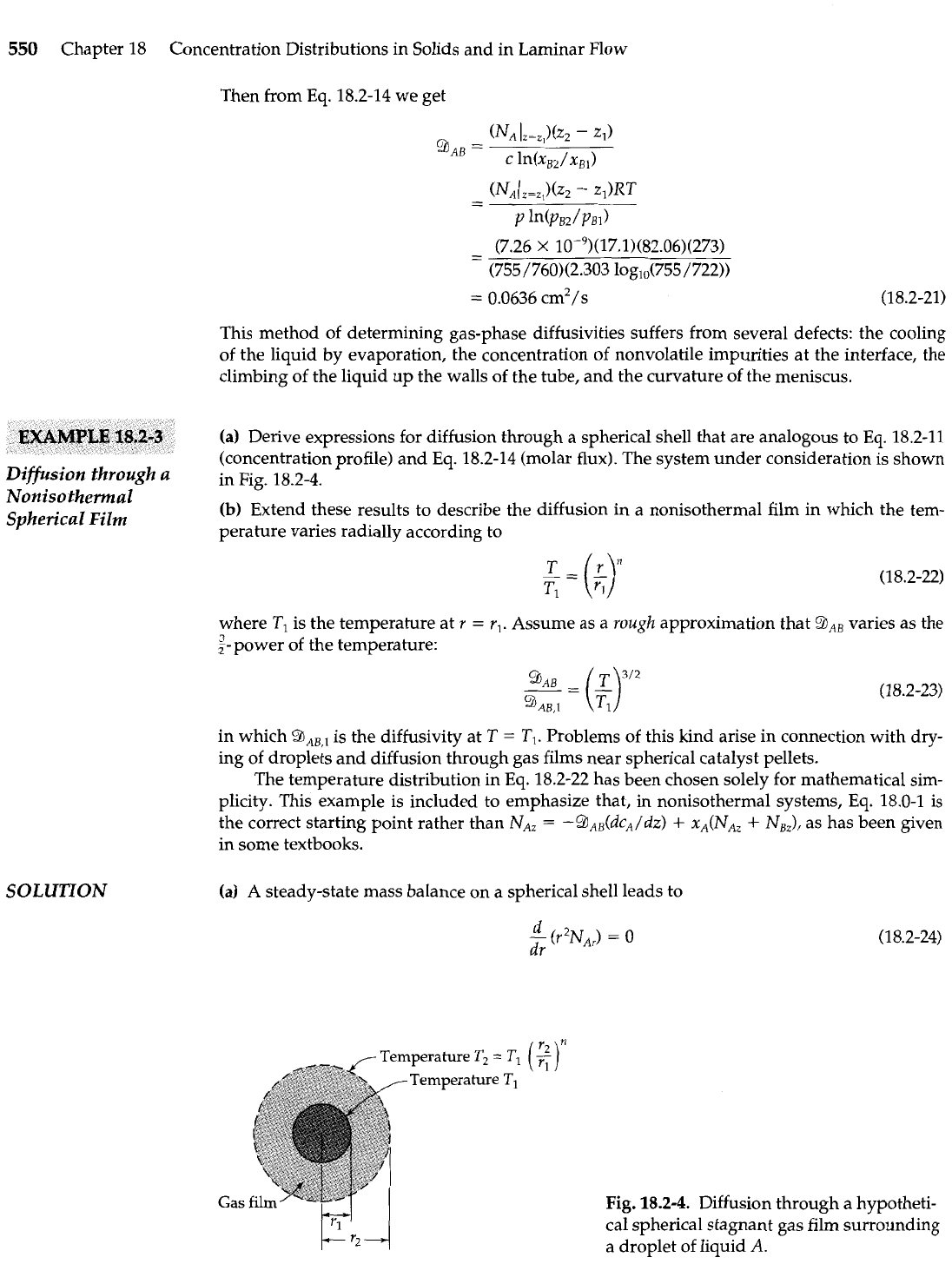
550
Chapter 18
Concentration Distributions in Solids and in Laminar Flow
Then from Eq. 18.2-14 we get
This method of determining gas-phase diffusivities suffers from several defects: the cooling
of the liquid by evaporation, the concentration of nonvolatile impurities at the interface, the
climbing of the liquid up the walls of the tube, and the curvature of the meniscus.
(a)
Derive expressions for diffusion through a spherical shell that are analogous to Eq. 18.2-11
(concentration profile) and
Eq.
18.2-14 (molar flux). The system under consideration
is
shown
Diffusion through a
in pin.
18.2-4.
Nonisothermal
Spherical Film
SOLUTION
-
(b)
Extend these results to describe the diffusion in a nonisothermal film in which the tem-
perature varies radially according to
where
TI
is the temperature at
r
=
r,.
Assume as
a
rough
approximation that
varies as the
$-power of the temperature:
in which is the diffusivity at
T
=
TI.
Problems of this kind arise in connection with dry-
ing of droplets and diffusion through gas films near spherical catalyst pellets.
The temperature distribution in Eq. 18.2-22 has been chosen solely for mathematical sim-
plicity. This example is included to emphasize that, in nonisothermal systems, Eq. 18.0-1 is
the correct starting point rather than NAz
=
-gAB(dcA/dz)
+
xA(NAz
+
NBz),
as has been given
in
some textbooks.
(a)
A steady-state mass balance on a spherical shell leads to
Fig.
18.2-4.
Diffusion through a hypotheti-
cal spherical stagnant gas film surrounding
a droplet of liquid
A.
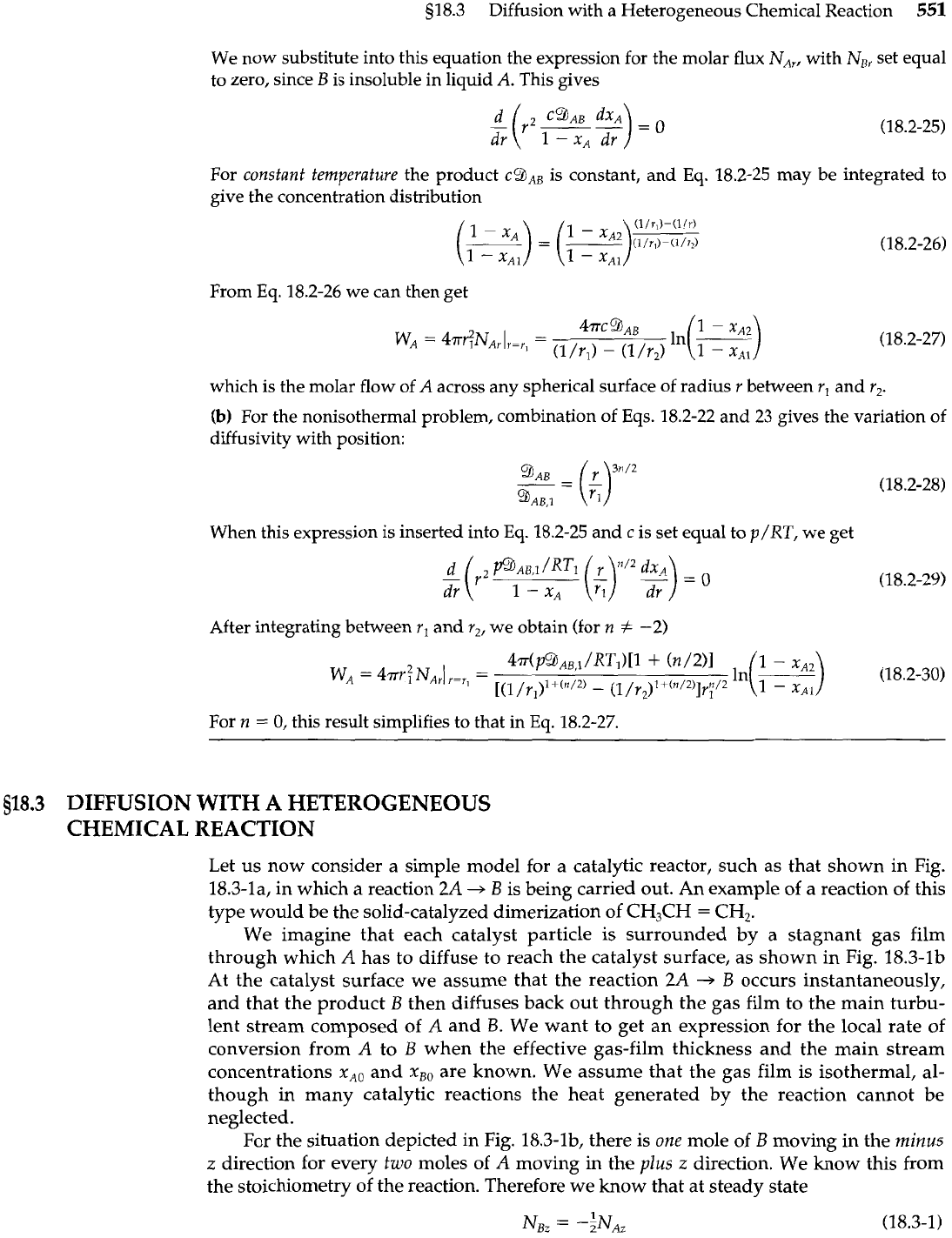
918.3 Diffusion with a Heterogeneous Chemical Reaction
551
We now substitute into this equation the expression for the molar flux NAr, with
NB,
set equal
to zero, since
B
is insoluble in liquid
A.
his-gives
For
constant temperature
the product
c9AB
is constant, and
Eq.
give the concentration distribution
From Eq. 18.2-26 we can then get
(18.2-25)
18.2-25 may be integrated to
which is the molar flow of
A
across any spherical surface of radius
r
between
r1
and
r,.
(b)
For the nonisothermal problem, combination of Eqs. 18.2-22 and 23 gives the variation of
diffusivity with position:
When this expression is inserted into
Eq.
18.2-25 and
c
is set equal to p/RT, we get
After integrating between
Y,
and
r,,
we obtain (for
n
#
-2)
For
n
=
0, this result simplifies to that in Eq. 18.2-27.
518.3
DIFFUSION WITH A HETEROGENEOUS
CHEMICAL REACTION
Let us now consider a simple model for a catalytic reactor, such as that shown in Fig.
18.3-la, in which a reaction
2A
+
B
is being carried out. An example of a reaction of this
type would be the solid-catalyzed dimerization of
CH,CH
=
CH,.
We imagine that each catalyst particle is surrounded
by
a stagnant gas film
through which
A
has to diffuse to reach the catalyst surface, as shown in Fig. 18.3-lb
At the catalyst surface we assume that the reaction
2A
+
B
occurs instantaneously,
and that the product
B
then diffuses back out through the gas film to the main turbu-
lent stream composed of
A
and
B.
We want to get an expression for the local rate of
conversion from
A
to
B
when the effective gas-film thickness and the main stream
concentrations
x,,,
and
x,,
are known. We assume that the gas film is isothermal, al-
though in many catalytic reactions the heat generated by the reaction cannot be
neglected.
For the situation depicted in Fig. 18.3-lb, there is
one
mole of
B
moving in the
minus
z
direction for every
two
moles of
A
moving in the
plus
z
direction. We know this from
the stoichiometry of the reaction. Therefore we know that at steady state
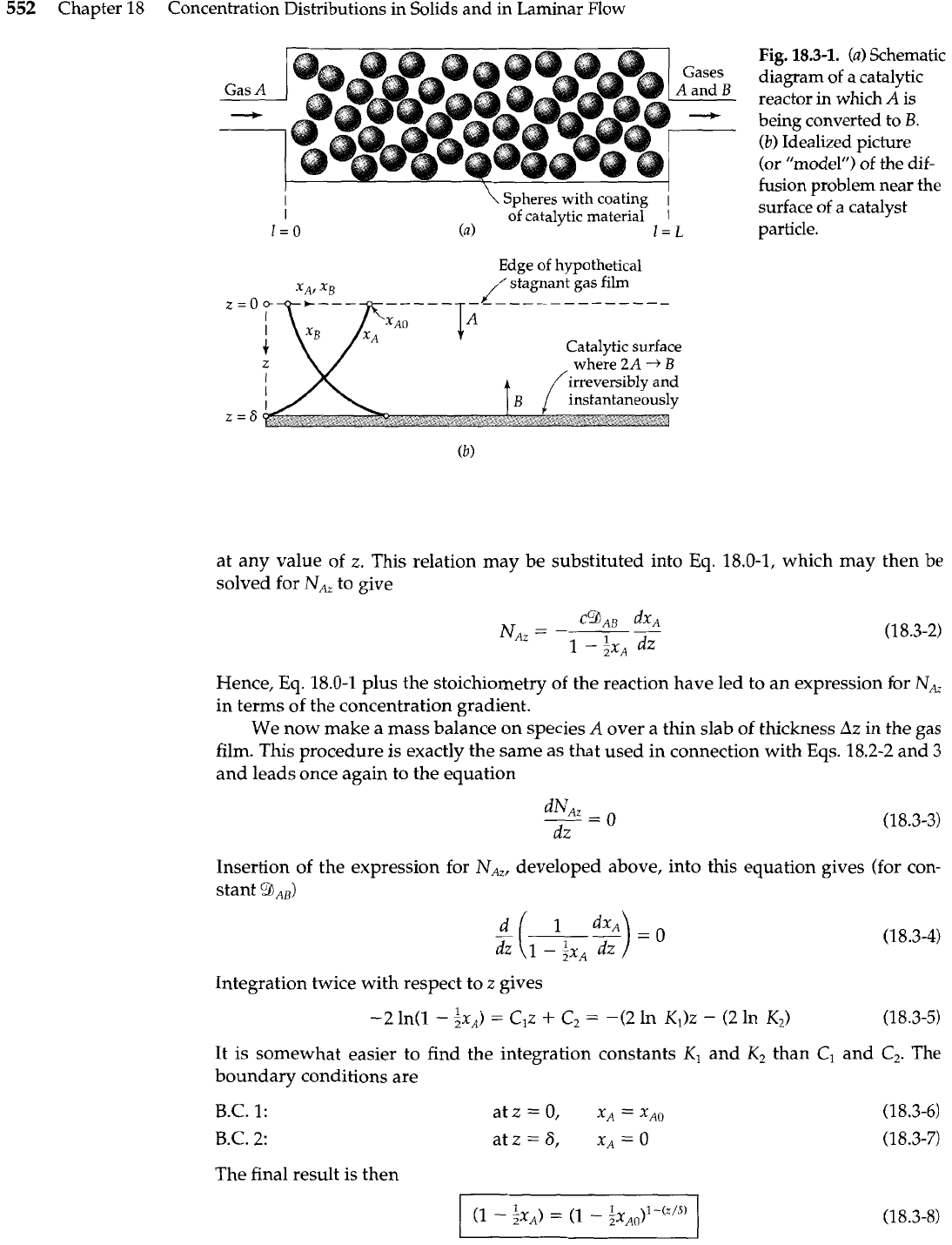
552
Chapter 18 Concentration Distributions in Solids and in Laminar Flow
Gas
A
-
Gases
A
and
B
-f
\
Spheres with coating
1
of catalytic material
I
(a)
I=L
Edge
of
hypothetical
/
stagnant
gas
film
Fig.
18.3-1.
(a)
Schematic
diagram of a catalytic
reactor in which
A
is
being converted to
B.
(b)
Idealized picture
(or
"rn~clel'~)
of
the dif-
fusion problem near the
surface of a catalyst
particle.
at any value of
z.
This relation may be substituted into Eq. 18.0-1, which may then be
solved for
NAZ
to give
Hence, Eq. 18.0-1 plus the stoichiometry of the reaction have led to an expression for
Nh
in terms of the concentration gradient.
We now make a mass balance on species
A
over a thin slab of thickness
Az
in the
gas
film. This procedure is exactly the same as that used in connection with Eqs. 18.2-2 and
3
and leads once again to the equation
Insertion of the expression for NAt, developed above, into this equation gives (for con-
stant
%,,)
Integration twice with respect to
z
gives
It is somewhat easier to find the integration constants
K,
and
K,
than
C1
and
C2.
The
boundary conditions are
B.C.
1:
B.C.
2:
The final result is then

s18.3 Diffusion with a Heterogeneous Chemical Reaction
553
for the concentration profile in the gas film. Equation 18.3-2 may now be used to get the
molar flux of reactant through the film:
The quantity
N,
may also be interpreted as the local rate of reaction per unit area of cat-
alytic surface. This information can be combined with other information about the cat-
alytic reactor sketched in Fig.
18.3-l(a)
to get the overall conversion rate in the entire
reactor.
One point deserves to be emphasized. Although the chemical reaction occurs instan-
taneously at the catalytic surface, the conversion of
A
to
B
proceeds at a finite rate
be-
cause of the diffusion process, which is "in series" with the reaction process. Hence we
speak of the conversion of
A
to
B
as being difision controlled.
In the example above we have assumed that the reaction occurs instantaneously at
the catalytic surface. In the next example we show how to account for finite reaction ki-
netics at the catalytic surface.
Rework the problem just considered when the reaction
2A
-+
B
is not instantaneous at the cat-
alytic surface at
z
=
6. Instead, assume that the rate at which
A
disappears at the catalyst-
with
a
coated surface is proportional to the concentration of
A
in the fluid at the interface,
Heterogeneous
Reaction
NAz
=
k;cA
=
k;cxA (18.3-10)
in which
k;
is a rate constant for the pseudo-first-order surface reaction.
SOLUTION
We proceed exactly as before, except that B.C.
2
in Eq. 18.3-7 must be replaced by
B.C.
2':
NA,
being, of course, a constant at steady state. The determination of the integration constants
from B.C. 1 and
B.C.
2'
leads to
From this we evaluate (dxA/dz)l,=, and substitute it into Eq. 18.3-2, to get
This is a transcendental equation for NAz as a function of xA,,
k;,
&IAB, and
6.
When
k;
is large,
the logarithm of 1
-
:(~,,/k:c) may be expanded in a Taylor series and all terms discarded
but the first. We then get
NA~
=
2c9~d6
in(
)
(k,
large) (18.3-14)
1
+
9,,/k;'~
1
-
PA,
Note once again that we have obtained the rate of the combined reaction and diffusion process.
Note also that the dimensionless group 9A,/k;6 describes the effect of the surface reaction ki-
netics on the overall diffusion-reaction process. The reciprocal of this group is known as the
second Damkohler number' Da"
=
k;6/gA,. Evidently we get the result in
Eq.
18.3-9 in the limit
as
Dan
-+
w.
'
G.
Damhohler,
Z.
Elektrochem.,
42,846-862
(1936).

554
Chapter
18
Concentration Distributions in Solids and in Laminar Flow
Gas
A
Fig.
18.4-1.
Absorption of
A
by
B
with a
homogeneous reaction in the liquid phase.
518.4
DIFFUSION WITH A HOMOGENEOUS
CHEMICAL REACTION
As the next illustration of setting up a mass balance, we consider the system shown in
Fig. 18.4-1. Here gas
A
dissolves in liquid
B
in a beaker and diffuses isothermally into the
liquid phase. As it diffuses, A also undergoes an irreversible first-order homogeneous
re-
action:
A
+
B
+
AB.
An example of such a system is the absorption of CO, by a concen-
trated aqueous solution
of
NaOH.
We treat this as a binary solution of
A
and
B,
ignoring the small amount of AB that is
present (the
pseudobinay assumption).
Then the mass balance on species
A
over a thick-
ness
Az
of the liquid phase becomes
in which
kq'
is a first-order rate constant for the chemical decomposition of A, and
S
is the
cross-sectional area of the liquid. The product
kq'cA
represents the moles of
A
consumed
by the reaction per unit volume per unit time. Division of Eq. 18.4-1 by
SAz
and taking
the limit as
Az
-+
0
gives
If the concentration of
A
is small, then we may to
a
good approximation write Eq. 18.0-1 as
since the total molar concentration
c
is virtually uniform throughout the liquid. Combin-
ing the last two equations gives
This is to be solved with the following boundary conditions:
B.C.
I:
B.C.
2:
at
z
=
0,
C~
=
C~O
at
z
=
L,
NA,
=
0
(or
dcn/dz
=
0)
The first boundary condition asserts that the concentration of A at the surface in the liq-
uid remains at a fixed value
c,,.
The second states that no A diffuses through the bottom
of the container at
z
=
L.
If
Eq. 18.4-4 is multiplied by
then it can be written in dimensionless vari-
ables in the form of Eq. C.l-4

s18.4
Diffusion with a Homogeneous Chemical Reaction
555
where
r
=
cA/cAO
is a dimensionless concentration,
5
=
z/L
is
a dimensionless length,
and
4
=
d
k;"L2/91AB
is
a
dimensionless group, known as the
Thiele modulus.'
This group
represents the relative influence of the chemical reaction
kycAO
and diffusion
c~~~~~/L~.
Equation 18.4-7 is to be solved with the dimensionless boundary conditions that at
5
=
0,
r
=
1, and at
5
=
1,
dr/dc
=
0.
The general solution is
I'
=
C,
cosh
$5
+
C,
sinh
+c
(18.4-8)
When the constants of integration are evaluated, we get
cosh
4
cosh
$5
-
sinh
4
sinh
45
cosh[+(l
-
5)1
r
=
-
-
(18.4-9)
cosh
$
cosh
4
Then reverting to the original notation
The concentration profile thus obtained is plotted in Fig. 18.4-1.
Once we have the complete concentration profile, we may evaluate other quantities,
such as the average concentration in the liquid phase
Also, the molar
flux
at the plane
z
=
0
can be found to be
This result shows how the chemical reaction influences the rate of absorption of gas
A
by
liquid
B.
The reader may wonder how the solubility
cAo
and the diffusivity
QAB
can be de-
termined experimentally if there is a chemical reaction taking place. First,
kr
can
be measured in a separate experiment in a well-stirred vessel. Then, in principle,
cAO
and
9AR
can be obtained from the measured absorption rates for various liquid
depths
L.
Estimate the effect of chemical reaction rate on the rate of gas absorption in an agitated tank
(see Fig.
18.4-2).
Consider a system in which the dissolved gas
A
undergoes an irreversible
Gas
with
first
order reaction with the liquid
B;
that is,
A
disappears within the liquid phase at a rate
Chemical Reaction
in
proportional to the local concentration of
A.
An example of such a system is the absorption of
an
Agitated Tank2
SO, or
H2S
in aqueous NaOH solutions.
E.
W.
Thiele,
Ind.
Eng.
Chem.,
31,916-920 (1939).
Ernest William Thiele
(pronounced "tee-lee")
(1895-1993) is noted for his work on catalyst effectiveness factors and his part in the development
of
the
"McCabe-Thiele" diagram. After 35 years with Standard Oil of Indiana, he taught for a decade at Notre
Dame University.
E.
N.
Lightfoot,
AIChE
Journal,
4,499-500 (1958), 8,710-712 (1962).
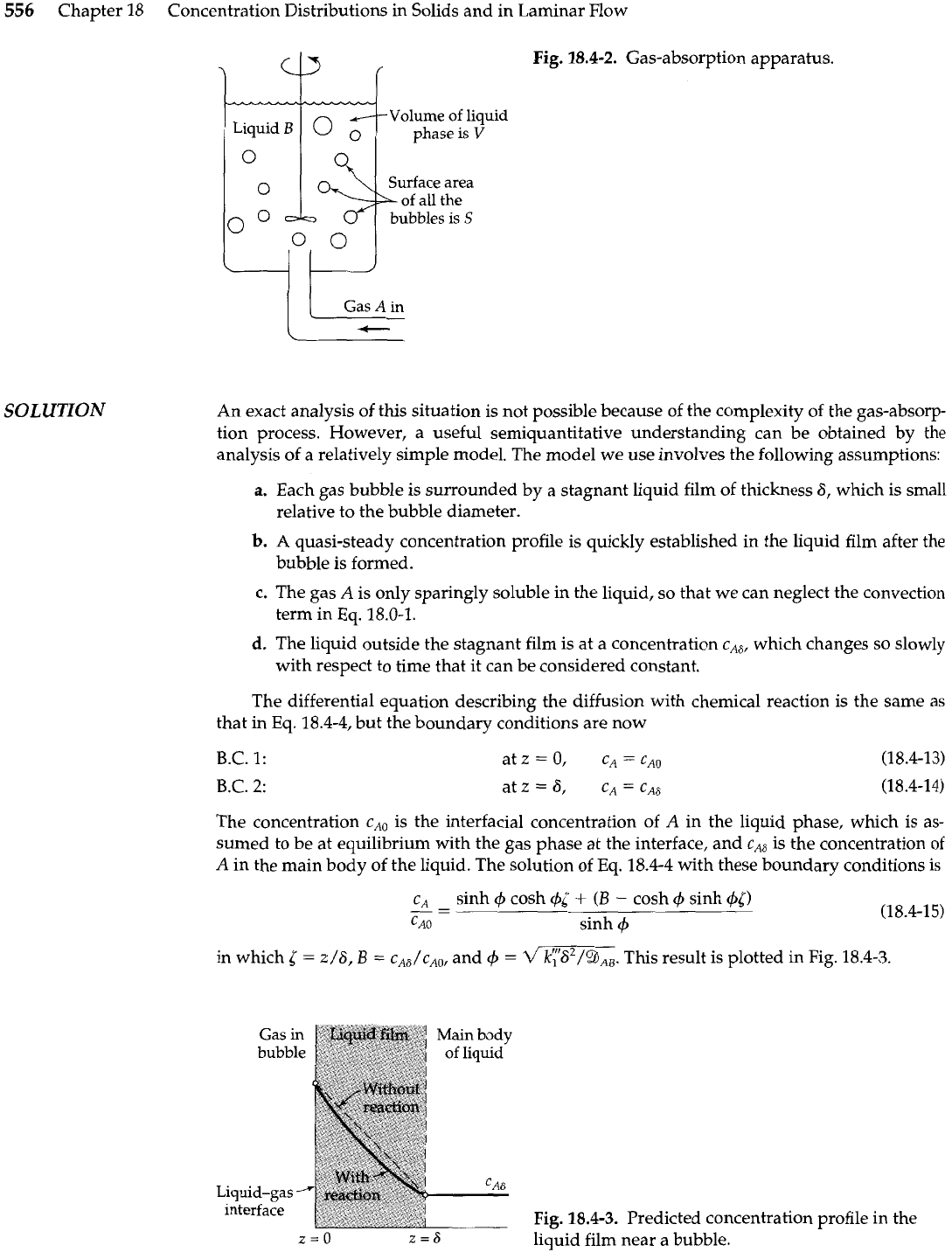
556
Chapter 18 Concentration Distributions in Solids and in
SOLUTION
Surface area
of
all the
bubbles is
S
0
0
Laminar Flow
Fig.
18.4-2.
Gas-absorption apparatus.
An exact analysis of this situation is not possible because of the complexity of the gas-absorp-
tion process. However, a useful semiquantitative understanding can be obtained by the
analysis of a relatively simple model. The model we use involves the following assumptions:
Each gas bubble is surrounded by a stagnant liquid film of thickness
6,
which is small
relative to the bubble diameter.
A
quasi-steady concentration profile is quickly established in the liquid film after the
bubble is formed.
The gas
A
is only sparingly soluble in the liquid, so that we can neglect the convection
term in
Eq.
18.0-1.
The liquid outside the stagnant film is at a concentration
CA&
which changes so slowly
with respect to time that it can be considered constant.
The differential equation describing the diffusion with chemical reaction is the same
as
that in
Eq.
18.4-4, but the boundary conditions are now
B.C. 1:
B.C.
2:
The concentration
cA,
is the interfacial concentration of
A
in the liquid phase, which is as-
sumed to be at equilibrium with the gas phase at the interface, and
cA,
is the concentration
of
A
in the main body of the liquid. The solution of Eq. 18.4-4 with these boundary conditions is
c,
-
sinh
4
cosh
+[
+
(B
-
cosh
4
sinh
4[)
--
CAO
sinh
4
(18.4-15)
in which
=
z/S,
B
=
cA8/cA0,
and
4
=
k',"6'/aAB.
This result is plotted in Fig. 18.4-3.
Gas in
bubble
Liquid-gas
-
interface
Main body
of
liquid
C~~
Fig.
18.4-3.
Predicted concentration profile in the
liquid film near
a
bubble.
